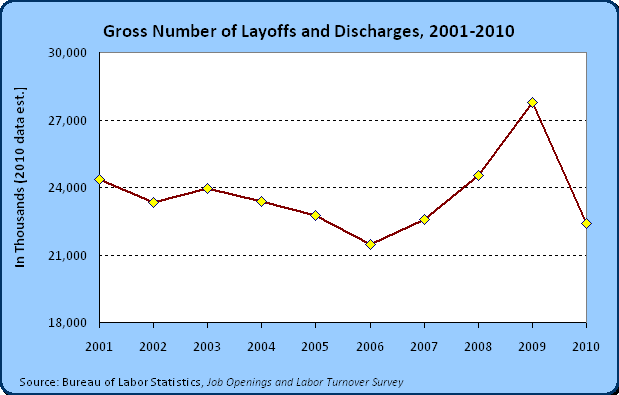Since the Bureau of Labor Statistic started collecting the data in 2001, the annual average number of jobs that have been “destroyed” in the US economy has been 23.7 million per year or roughly 2 million jobs per month.
Now these “jobs” are not the same as employment experiences. Some of the people represented in these job losses are counted more than once. But just to put this in perspective, the labor force in the United States is about 150 million people. What this chart tells us (ignoring the difference between jobs and workers) is that roughly one-seventh of the labor force experiences dislocation in any given year. That’s a lot of turnover. What lessons can we draw from this?
- In order for unemployment to remain stable (which it had before the recession) this means that the economy must be creating well more than 23 million jobs each year. That’s the creative part of creative destruction that is totally ignored in the popular view. Why more than 23 million? To accommodate population and labor force increases.
- The major problem today is not that firings and layoffs are out of the ordinary, indeed 2010 is on pace to be a slightly below average year. The major problem is that new jobs are not being created as fast as they have been in the past. The Keynesians think it is because of weak “aggregate demand” (despite the rapid increase in consumer spending in the last year). The monetarists think it is because of an increase in the demand for real money balances. Some economists think it is because workers and firms are having a harder time finding each other and “matching” to each other (but unemployment right now is highest among the groups with the lightest search and matching costs – the construction sector for example and the young). Other economists think it is because the economy is undergoing a major restructuring, and that neither the Keynesian planning mentality nor the simple short-term market pricing approach can do anything to speed this process along. Just as in the 19th century we moved from an agricultural to a manufacturing economy and in the 20th from a manufacturing to a service economy, right now we are in the process of another major transition. To what? Well, that is the problem. Of course, I am most sympathetic to the last point.
- The fact that there can be so much turnover yet our economy continues to grow seems to me to demonstrate how much unproductive work is being done in an economy each year. I don’t have data or an analysis to provide right now, but I would argue that 95% of the valuable output in the economy is produced by well less than half the labor force. Or that a substantial portion of the labor force is destroying value. This point should be more subtly presented, which I will try to do in a later post.

“Or that a substantial portion of the labor force is destroying value.”
Indisputable if we include the public sector.
Salem sure has that right.
One of the most destructive developments has been the explosion of government workers in all levels of government in the past two years. Most of them don’t produce anything, but instead are just a source of friction on the velocity of money. Sure, overpaid government workers are consumers and help keep the Washington, DC, area booming, but far too much government-worker output is pure destruction of wealth.
Now, this is not to say that everyone earning a paycheck from the government is a useless blob. I like the idea that we have the best military in the world, and I’m sure there are good people working in the CIA, State Department and so on. But I would bet that at least fifty percent of all government workers don’t do anything worthwhile all day. Maybe more than fifty percent.
Our township is a classic example. In 1979, our supervisors disbanded the police force after coming to the conclusion that their main accomplishment was wearing out police cars. (I live in a low-crime area.) Since then, the state police cover our township and all other municipalities that don’t have local police of their own. Having eliminated the expenses of a police force, our township reduced the real estate tax millage to zero. The townshp did not need the money, as a half percent earned income tax and state liquid fuels taxes were enough to maintain the roads, which was the main function of township government back then. I ran for supervisor against the former chief of police: I was the no-tax, no-police candidate and he was the pro-tax, pro-police candidate. Guess who won?
Back then we had one clerical employee, the township’s secretary, and three people on the road crew. Since then, however, various boards of supervisors have added three clerical people, including a township manager who has a $10,000 spending idea every month. The township has also purchased open space and parkland and most recently has frittered away $3.3 million on a new maintenance building, a salt shed and three playfields at the township’s new “Camelot Park.” I predict that sometime next year the road crew will grow by at least one employee who will cut the grass at Camelot Park.
One might argue that it’s good to provide parks and recreational facilities for the proletariats, but I’d rather see private groups like the little league raise money to buy and build baseball fields. Instead, the little league folks complain to the supervisors that they can’t raise the money, and they want the supervisors to levy taxes or extort money from developers to build more playfields. What would King Arthur say about all of this?